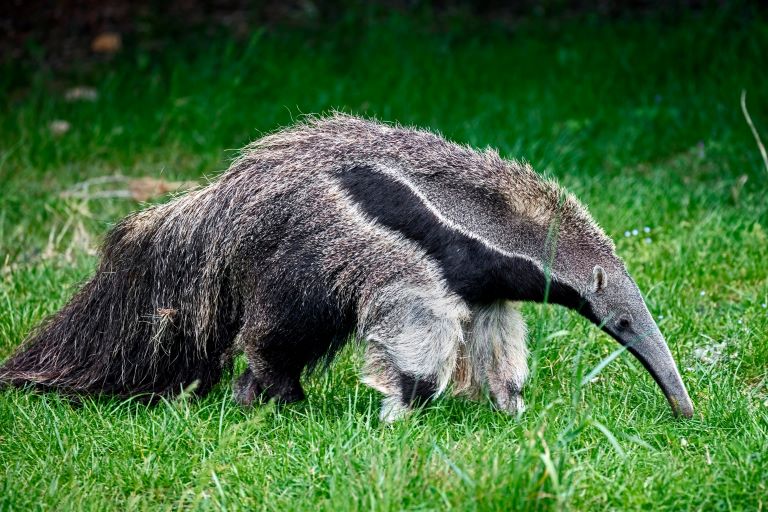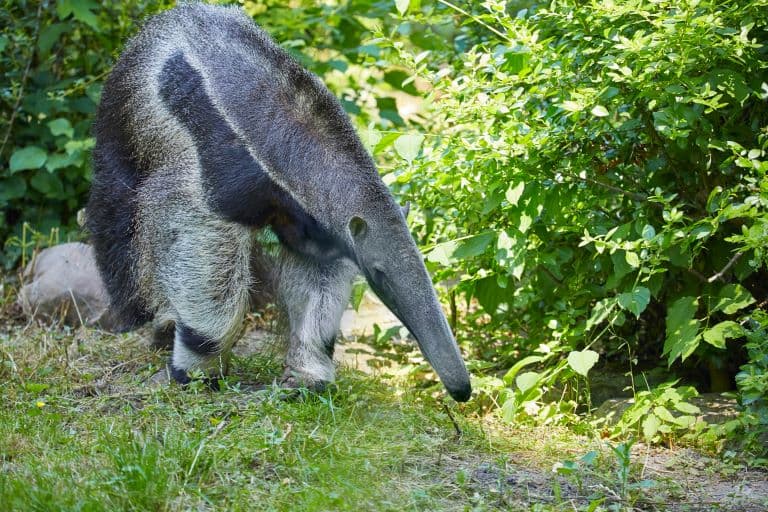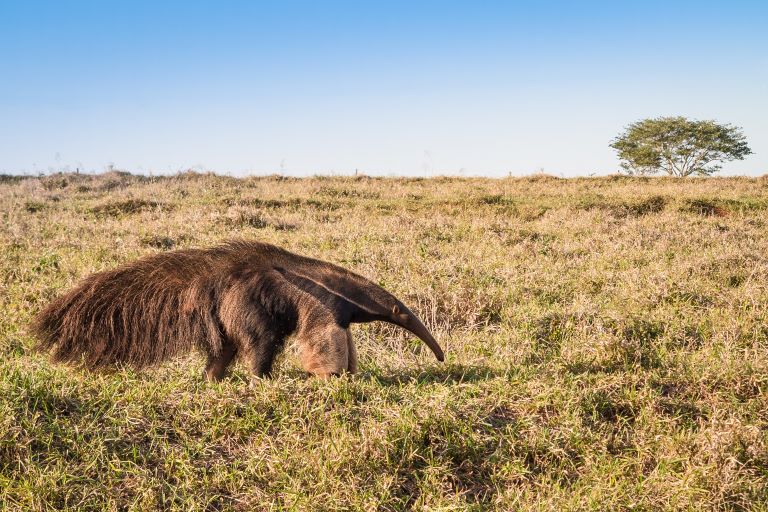Anteater Profile
Believe it or not, but there are not just one species of anteater. Instead, there are four different species, and each one is equally amazing!
Anteaters are some of the most unique animals on the planet. From their strange appearances to their insect-based diet, there aren’t many animals like them. Typically, anteaters can only be found in Central and South America. They are carnivores and are either nocturnal or diurnal depending on the area in which they live.

Anteater Facts Overview
| Habitat: | Grasslands and rainforests |
| Location: | Central and South America |
| Lifespan: | Up to 14 years |
| Size: | 1.2 to 1.8 meters long |
| Weight: | Up to 50 kilograms |
| Color: | White, grey, black, and brown |
| Diet: | Ants and termites |
| Predators: | Large wild cats like jaguars and pumas |
| Top Speed: | Up to 48 kilometers per hour |
| No. of Species: | 4 |
| Conservation Status: | Vulnerable |
Although they may not look the same, we actually have similar names for pigs and anteaters. That’s right! A male anteater is known as a boar, while a female is known as a sow. However, the similarities end there. This is because young anteaters are known as pups!
Although their conservation status may vary, anteaters are viewed as vulnerable species in several areas. This is especially true for the giant anteater. There are two main causes for this status: loss of habitat and increased deaths as a result of traffic. 1The latter becomes more prevalent in the four species of anteater the closer to human cities they live.
Interesting Anteater Facts
1. They’re named for their tongue.
The four species of anteater can be found in the suborder Vermilingua. This word is a combination of New Latin and Latin, and it can be translated to mean “worm tongue”! Although the anteater doesn’t eat worms, it does have a long, serpentine tongue that resembles a worm. This helps them eat insects from ant hills and termite mounds.
2. Anteaters are most closely related to sloths.
Although they may not look the same, anteaters are actually related to sloths. Together, they make up the order Pilosa, which means “hairy”.

3. There are several extinct species of anteater.
Although we’re able to see and enjoy four different species of anteater, there used to be many more. In fact, there are five totally extinct genera of anteater, with up to several species included in each extinct genus.
One of the most notable is the genus Palaeomyrmidon. Its closest living relative is the silky anteater. 2
4. True anteaters are only distantly related, if related at all, to other “anteaters”.
There are only four living species of anteaters. However, many other animals, such as the pangolin, also claim the name of “anteater”. Despite this, other anteaters outside the order of Pilosa are only distantly related to the anteaters.
5. They walk on their knuckles.
One of the most notable features of the anteater is their large claws. These are used to help dig and are useful when it comes to ant hills and termite mounds where their preferred prey lives.
However, although their claws can be useful tools, they can make it difficult to walk. As a result, you’ll often see anteaters walking like many primates do: on their knuckles!

6. Anteaters use their tails as blankets.
Another notable feature of the anteater is their long, fluffy tails. In fact, this hairy tail is probably one reason that their order earned the name of Pilosa, or “hairy”!
This tail is for more than just aesthetic purposes, however. It’s actually quite beneficial to their day-to-day life. Although their habitat is known for its warm, humid temperatures, it can be cold at night or during poor weather. As a result, anteaters have grown to use this fluffy tail as a blanket.
7. They’ve attacked humans!
Typically, anteaters are fairly docile creatures. They’re carnivorous, but they only eat insects. And, although they can look intimidating, their long claws are for digging.
This doesn’t mean that they won’t defend themselves as necessary, however. Anteaters have been known to use their claws to attack whenever they feel threatened. This includes by humans, who have been seriously injured or even killed by a defensive anteater!
8. Anteaters have poor sight.
Believe it or not, but anteaters actually have poor vision. Instead, they rely on their hearing and sense of smell, both of which are extremely strong and accurate. In fact, an anteater’s sense of smell is said to be as much as 40 times strong than a human’s!

9. They have some of the lowest body temperatures among types of mammals.
Although they’re large, fluffy mammals, anteaters don’t have a high body temperature. Their average body temperature is only 32.7 degree Celsius, making it much lower than a human’s. They’re often regarded as having the lowest body temperatures of all mammals.
10. Three of the four species have a prehensile tail!
When you think of a prehensile tail, you’ll probably think of different species of monkeys. A prehensile tail is one that is strong and can act as an additional hand, allowing animals to hang from branches and more.
However, while it may be more commonly associated with primates, three of the four species of anteater also have a prehensile tail! That’s all of them except for the giant anteater.
Anteater Fact-File Summary
Scientific Classification
| Kingdom: | Animalia |
| Phylum: | Chordata |
| Class: | Mammalia |
| Order: | Pilosa |
Fact Sources & References
- Carlos H(2014), “Road-kills of the giant anteater in south-eastern Brazil: 10 years monitoring spatial and temporal determinants”, Research Gate.
- “Palaeomyrmidon”, The Paleobiology Database.
